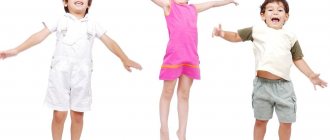Anxiety disorders
- These are neurosis-like mental states, the main symptom of which is a feeling of anxiety.
Such conditions differ from the usual fears and anxieties that can always be observed in children during their development. Feelings of fear, danger, anxiety are the most important adaptive signals in the psyche of every person and accompany us throughout our lives. But in certain cases, the mechanisms that regulate the intensity and duration of anxiety fail and then the normal course of psycho-emotional development is disrupted.
Anxiety disorders can be of several types depending on their manifestation:
Social anxiety disorder
- fears of meeting or communicating with people;
- avoidance of social situations;
- lack of friends outside the family
STORY
The girl Olya, 10 years old, was very often worried. Every morning she worried whether she would be late for school, although she always arrived at school on time. Every day she worried, did she put everything in her backpack? At night she worried about whether she had done her homework well and whether her clothes would look neat the next day?
Olya's parents thought this behavior was a typical part of growing up. Gradually, the girl began to study worse, was often in a depressed mood, and her relationships with her friends went wrong. Unable to influence their daughter, to change her attitude to what was happening, the parents decided that it was time to talk with a specialist about how to find a way to help Olya cope with her anxiety.
Article:
Anxiety and anxiety. What are the differences
The word "anxious" has been noted in dictionaries since 1771.
There are many versions explaining the origin of this term. The author of one of them believes that the word “alarm” means a three-time repeated signal about danger from the enemy. The psychological dictionary gives the following definition of anxiety: it is “an individual psychological characteristic consisting in an increased tendency to experience anxiety in a wide variety of life situations, including those that do not predispose one to this.”
It is necessary to distinguish anxiety from anxiety. If anxiety is episodic manifestations of a child’s restlessness and excitement, then anxiety is a stable condition.
For example, it happens that a child gets nervous before speaking at a party or answering questions at the blackboard. But this anxiety does not always manifest itself; sometimes in the same situations he remains calm. These are manifestations of anxiety. If the state of anxiety is repeated frequently and in a variety of situations (when answering at the board, communicating with unfamiliar adults, etc.), then we should talk about anxiety.
Anxiety is not associated with any specific situation and appears almost always. This condition accompanies a person in any type of activity. When a person is afraid of something specific, we talk about the manifestation of fear. For example, fear of the dark, fear of heights, fear of enclosed spaces.
Fear can develop in a person at any age: children from one to three years old often have night terrors; in the 2nd year of life, fear of unexpected sounds, fear of loneliness, fear of pain (and the associated fear of medical workers) most often manifests itself. At 3-5 years old, children are characterized by fears of loneliness, darkness and confined spaces. At the age of 5-7 years, the fear of death becomes dominant. From 7 to 11 years old, children are most afraid of “not being someone who is well spoken of, respected, appreciated and understood.”
Causes of childhood anxiety
- Conflicting demands made by parents, or parents and school (kindergarten). For example, parents do not allow a child to go to school because he is not feeling well, and the teacher puts a “D” in the register and scolds him for missing a lesson in the presence of other children.
- Inadequate requirements (most often excessive). For example, parents repeatedly tell their child that he must be an excellent student; they cannot and do not want to come to terms with the fact that their son or daughter gets more than just “A” grades at school and is not the best student in the class.
- Negative demands that humiliate the child and put him in a dependent position. For example, a teacher or teacher says to a child: “If you tell me who behaved badly in my absence, I won’t tell mom that you got into a fight.”
Psychological portrait of an anxious child
A child is included in a kindergarten group (or class). He intensely peers at everything that is around him, timidly, almost silently greets and sits awkwardly on the edge of the nearest chair. He seems to be expecting some trouble. This is an anxious child. There are a lot of such children in kindergarten and school, and it is not easier for psychologists to work with them, but even more difficult than with other categories of “problem” children, because both hyperactive and aggressive children are always in plain sight, while anxious children try keep your problems to yourself.
They are characterized by excessive anxiety, and sometimes they are afraid not of the event itself, but of its premonition. They often expect the worst. Children feel helpless and are afraid to play new games and start new activities. They have high demands on themselves and are very self-critical. Their level of self-esteem is low; such children really think that they are worse than others in everything, that they are the ugliest, stupidest, and clumsy. They seek encouragement and approval from adults in all matters.
Anxious children are also characterized by somatic problems: abdominal pain, dizziness, headaches, spasms in the throat, difficulty shallow breathing, etc. When anxiety manifests itself, they often feel a dry mouth, a lump in the throat, weakness in the legs, and rapid heartbeat.
How to identify an anxious child
An experienced educator, teacher, psychologist, of course, in the very first days of meeting children will understand which of them has increased anxiety. However, before drawing final conclusions, it is necessary to observe the child causing concern on different days of the week, during school and free activities (at recess, on the street), in communication with other children.
To understand a child and find out what he is afraid of, you can ask parents, educators (or subject teachers) to fill out a questionnaire. Answers from adults will clarify the situation and help trace the family history. And observations of the child’s behavior will confirm or refute your assumption.
It is advised to take a closer look at whether the following signs are characteristic of the child’s behavior.
Criteria for determining anxiety in a child (P. Baker and M. Alvord):
- Constant anxiety.
- Difficulty, sometimes inability to concentrate on anything.
- Muscle tension (for example, in the face, neck).
- Irritability.
- Sleep disorders.
It can be assumed that a child is anxious if at least one of the criteria listed above is constantly manifested in his behavior. In order to identify an anxious child, the following questionnaire is also used
Signs of anxiety (Lavrentyeva G.P., Titarenko T.M.):
Anxious child 1. Cannot work for a long time without getting tired. 2. It is difficult for him to concentrate on something. 3. Any task causes unnecessary anxiety. 4. While performing tasks, he is very tense and constrained. 5. Feels embarrassed more often than others. 6. Often talks about tense situations. 7. As a rule, blushes in unfamiliar surroundings. 8. Complains that he has terrible dreams. 9. His hands are usually cold and wet. 10. He often has upset bowel movements. 11. Sweats a lot when excited. 12. Doesn't have a good appetite. 13. Sleeps restlessly and has difficulty falling asleep. 14. He is timid and fears many things. 15. Usually restless and easily upset. 16. Often cannot hold back tears. 17. Does not tolerate waiting well. 18. Doesn't like to take on new things. 19. I am not confident in myself, in my abilities. 20. Afraid to face difficulties.
Add up the number of “pluses” to get an overall anxiety score:
- High anxiety - 15-20 points;
- Average - 7-14 points;
- Low - 1-6 points .
How to help an anxious child
Working with an anxious child is associated with certain difficulties and, as a rule, takes quite a long time. Experts recommend working with anxious children in three areas:
- Increased self-esteem.
- Teaching a child the ability to manage himself in specific, most exciting situations.
- Relieving muscle tension.
Let's take a closer look at each of these areas.
Increased self-esteem
Of course, it is impossible to increase a child’s self-esteem in a short time. It is necessary to carry out targeted work every day. Call your child by name, praise him even for minor successes, celebrate them in the presence of other children. However, your praise must be sincere, because children react strongly to falsehood. Moreover, the child must know why he was praised. In any situation you can find a reason to praise your child.
It is advisable that anxious children more often participate in such games in a circle as “Compliments”, “I give you...”, which will help them learn a lot of pleasant things about themselves from others, and look at themselves “through the eyes of other children.” And so that others know about the achievements of each student or pupil, in a kindergarten group or in a classroom you can set up a “Star of the Week” stand, where once a week all the information will be devoted to the successes of a particular child.
Each child will thus have the opportunity to be the center of attention of others. The number of sections for the stand, their content and location are discussed jointly by adults and children.
You can highlight the child’s achievements in daily information for parents (for example, on the “We are today” stand): “Today, October 21, 2017, Seryozha conducted an experiment with water and snow for 20 minutes.” Such a message will provide an additional opportunity for parents to show their interest. It will be easier for the child to answer specific questions rather than recall everything that happened in the group during the day.
In the locker room of the kindergarten, on each child’s locker you can attach a “Seven-Colored Flower” (or “Flower of Achievement”), cut out of colored cardboard. In the center of the flower is a photograph of a child. And on the petals corresponding to the days of the week there is information about the child’s results, which he is proud of.
In the younger groups of the kindergarten, teachers enter information into the petals, and in the preparatory group, filling out the seven-colored flowers can be entrusted to the children. This will stimulate learning to write. In addition, this form of work helps to establish contacts between children, since those who do not yet know how to read or write often turn to their friends for help. Parents, coming to kindergarten in the evening, rush to find out what their child has achieved during the day, what his progress is.
Positive information is very important for both adults and children to establish mutual understanding between them. Moreover, it is needed for parents of children of any age.
Teaching children the ability to manage their behavior
As a rule, anxious children do not openly communicate about their problems, and sometimes even hide them. Therefore, if a child tells adults that he is not afraid of anything, this does not mean that his words are true. Most likely, this is a manifestation of anxiety, which the child cannot or does not want to admit.
In this case, it is advisable to involve the child in a joint discussion of the problem. In kindergarten, you can talk to children, sitting in a circle, about their feelings and experiences in situations that worry them. And at school, using examples of literary works, you can show children that a brave person is not one who is not afraid of anything (there are no such people in the world), but one who knows how to overcome his fear.
It is advisable for each child to say out loud what he is afraid of. You can invite children to draw their fears, and then show the drawing in a circle and talk about it. Such conversations will help anxious children realize that many of their peers have problems similar to those that they thought were unique to them.
Of course, all adults know that children cannot be compared with each other. However, when it comes to anxious children, this technique is categorically unacceptable. In addition, it is advisable to avoid competitions and activities that force one to compare the achievements of some children with the achievements of others. Sometimes even such a simple event as a sports relay race can become a traumatic factor.
It is better to compare the child’s achievements with his own results shown, for example, a week ago. Even if the child did not complete the task at all, in no case should you tell the parents: “Your daughter completed the appliqué worst of all” or “Your son finished the drawing last.”
Relieving muscle tension
It is advisable to use skin-to-skin games when working with anxious children. Relaxation exercises, deep breathing techniques, yoga, massage and simply rubbing the body are very useful.
Another way to relieve excessive anxiety is to paint your face with your mother’s old lipsticks. You can also arrange an impromptu masquerade or show. To do this, you need to prepare masks, costumes, or just old adult clothes. Taking part in a performance can help anxious children relax. And if the masks and costumes are made by children (with the participation of adults, of course), the game will bring them even more pleasure.
Working with parents of an anxious child
It is clear that no parent wants their child to become anxious. However, sometimes the actions of adults contribute to the development of this quality in children.
Often parents make demands on their child that they cannot meet. The baby cannot understand how and how to please his parents, and unsuccessfully tries to achieve their favor and love. But, having suffered one failure after another, he realizes that he will never be able to fulfill everything that his mother and father expect from him. He admits that he is not like everyone else: worse, worthless, and considers it necessary to make endless apologies.
To avoid the frightening attention of adults or their criticism, the child physically and mentally restrains his internal energy. He gets used to breathing shallowly and frequently, his head goes into his shoulders, the child acquires the habit of carefully and unnoticed slipping out of the room. All this does not at all contribute to the development of the child, the realization of his creative abilities, and interferes with his communication with adults and children, therefore the parents of an anxious child must do everything to assure him of their love (regardless of his success), of his competence in any area ( There are no completely incapable children).
First of all, parents should celebrate his successes daily, communicating them in his presence to other family members (for example, during a common dinner). In addition, it is necessary to abandon words that humiliate the child’s dignity (“donkey”, “fool”), even if the adults are very annoyed and angry. There is no need to demand an apology from the child for this or that action; it is better to let him explain why he did it (if he wants). If a child apologizes under pressure from his parents, this may cause him not to repent, but to become embittered.
It is useful to reduce the number of comments. Invite parents to try to write down all the comments made to the child during just one day. In the evening, have them reread the list. Most likely, it will become obvious to them that most of the comments could not have been made: they either did not bring any benefit or only harmed you and your child.
You cannot threaten children with impossible punishments: (“Shut up, otherwise I’ll glue your mouth shut! I’ll leave you! I’ll kill you!”). They are already afraid of everything in the world. It is better if, as a preventative measure, without waiting for an extreme situation, parents talk more with their children and help them express their thoughts and feelings in words.
The affectionate touch of parents will help an anxious child gain a sense of confidence and trust in the world, and this will relieve him of the fear of ridicule and betrayal. Parents of an anxious child should be unanimous and consistent in rewarding and punishing him. A child, not knowing, for example, how his mother will react to a broken plate today, is even more afraid, and this leads him to stress.
Parents of anxious children often experience muscle tension themselves, so relaxation exercises can be beneficial for them too. But, unfortunately, our relationship with our parents does not always allow us to openly tell them about this. Not everyone can be advised to pay attention first of all to themselves, to their internal state, and then make demands on the child. In such situations, you can tell the parents: “Your child is often stiff, he would benefit from muscle relaxation exercises. It is advisable that you do the exercises with him, then he will do them correctly.”
Parents who follow these recommendations after a while notice pleasant sensations in the body and an improvement in their general condition. They are usually ready for further cooperation.
Such classes can be recommended not only to parents, but also to teachers. After all, it’s no secret that parents’ anxiety is often transmitted to children, and teacher’s anxiety is often transmitted to students and pupils. That is why, before helping a child, an adult must take care of himself.
Prevention of childhood anxiety: recommendations from a psychologist to parents
- When communicating with your child, do not undermine the authority of other people significant to him. (For example, you should not tell a child: “Your teachers understand a lot! You better listen to your grandmother!”)
- Be consistent in your actions, do not forbid your child without any reason to do something that you previously allowed.
- Consider the capabilities of children, do not demand from them what they cannot do. If a child has difficulty in any academic subject, it is better to once again help him and provide support, and if he achieves even the slightest success, do not forget to praise him.
- Trust your child, be honest with him and accept him for who he is.
- If for some objective reason it is difficult for a child to study, choose a circle for him that he likes, so that classes in it bring him joy and he does not feel disadvantaged.
Causes of anxiety disorders
It is difficult to name the exact cause of such a disorder in a child, as well as in an adult. Experts name a number of provoking factors:
- Genetic predisposition.
Having an anxiety disorder in a parent increases the risk of similar symptoms in a child. - Stressful life circumstances.
Events in a child’s life can become a starting point (trigger) for anxiety disorders in childhood or adulthood: loss (death of a loved one or divorce of parents), life changes (moving to a new city, changing schools, going to kindergarten). Children who have experienced abuse are more likely to have anxiety disorders. - Upbringing
. Growing up in a home where other family members are constantly anxious can teach a child to view the world as a dangerous place. If a child grows up in a truly dangerous environment (domestic violence), he may experience excessive stress, fear and expect the worst.
Forms of increased anxiety
There are two forms of childhood anxiety:
- Open. The child consciously experiences certain emotions and demonstrates them through his behavior.
- Hidden. When the child himself does not realize that he is experiencing anxiety. This may manifest itself in excessive calmness, apathy, or even denial of any discomfort.
The second type of anxiety is much less common; its main symptom is considered to be the so-called “inadequate calm.” The child is so worried that he carefully hides it and demonstrates complete calm and detachment from the situation.
Helping an anxious child
Anxiety disorders in children are dealt with by mental health specialists: psychologists, psychotherapists, psychiatrists. The specialist analyzes the symptoms, diagnoses a specific anxiety disorder, and outlines a plan to help the child.
Through work with a psychologist, children learn to think and act differently in situations that may cause anxiety, as well as cope with stress. The specialist provides support and guidance. Sometimes drug treatment is necessary.
What is anxiety
In recent years, the number of children suffering from some form of anxiety disorder has increased. This is due to many factors: a tense situation in families, immersion in the world of the Internet and gadgets, etc.
But for the most part, anxiety in children arises from the dissatisfaction of their age-related needs. Babies need a sense of security and the constant presence of their mother. Preschool children show increased anxiety in unfamiliar surroundings or are afraid of the dark. Teenagers need trust and respect, recognition of their right to their own opinion and freedom of choice.
Anxiety in psychological literature
This condition is described in many works of eminent psychologists. Thus, S. Freud identified three forms of anxiety:
- Real fear is a feeling of danger that some event or phenomenon carries.
- Neurotic anxiety is a fear of something unknown, irrational fear.
- Moral anxiety is a product of one’s own ego, that is, pangs of conscience, feelings of guilt, etc.
A. Adler considered the cause of increased anxiety to be a feeling of inferiority. But A. Prikhozhan explained this condition by the presence of emotional discomfort from a real or imaginary problem.
How parents can help
- The best way to help your child is to acknowledge the problem and provide support without criticism. Try to observe more carefully what causes difficulties for your child in everyday life and how he reacts to them.
- Contact a specialist to assess the child's condition.
- Be patient and positive if psychotherapy . In the process, the child will learn new ways of coping with anxiety.
- Sometimes it helps to talk to your child about your own stresses and how you were able to overcome them.
- Rest assured that with the right approach, your child will be able to overcome anxiety , learn to look into the future without unnecessary stress, and realize their full potential.
Exercises to reduce anxiety in children
Also, the recommendations of the French teacher M. Borba can help an anxious child. She offers several simple exercises that are aimed at relieving stress in children. They can be used in combination or separately. They turn anxiety management into a game, which improves performance. [2]
- Internal dialogue. Find a phrase with your child that will increase his self-confidence and teach him to say it in a stressful situation. For example: “I will succeed”, “I can handle this”, “There is no reason to worry.”
- Elevator breathing. Invite your child to close his eyes, exhale three times, and then imagine that he is going down in an elevator from the top floor to the first. Once the elevator reaches its destination, the excitement will disappear. You can also use any other breathing exercises to combat anxiety.
- Melting away stress. Ask your child to find a place where tension accumulates. Usually this is the neck, shoulders, jaws. You need to strongly tense this place, and then sharply relax it and feel how the clamp leaves the body.
- Visualization of a calm place. When a child is overcome by anxiety, he can imagine a place where he feels calm and happy. This helps because, firstly, the child is mentally transported to a safe environment, and secondly, in principle, he is distracted from restless thoughts.
Therapy for TR
Treatment of TD in children and adolescents is based on an integrated approach using methods of psychotherapy (rational, cognitive-behavioral, family, play, etc.) and pharmacotherapy. An important role belongs to parents who, following the recommendations of a specialist, help their child cope with anxiety. When coping skills and courageous behavior are practiced and encouraged at home, children and adolescents learn to face their fears, take smart risks, and gain confidence in their own abilities.
In pharmacotherapy, drugs of several groups are used, including non-benzodiazepine tranquilizers (hydroxyzine), tranquilonotropics (aminophenylbutyric acid hydrochloride), drugs with sedative and vegetative-stabilizing effects (affinity-purified antibodies to the brain-specific protein S-100), selective serotonin reuptake inhibitors (fluvoxamine, sertraline), mild antipsychotic drugs (alimemazine), herbal medicines. It should be noted that there is a need for long-term medical supervision and long-term therapy.
For children and adolescents with various forms of TR, complex medications may be recommended, including neurometabolic agents, vitamins, macro- and microelements. Such a drug is “KidZ syrup with lemon balm and mint,” which is prescribed in courses of 2 weeks. in the following doses:
child from 3 to 7 years old - 5 ml 2 times a day;
child from 7 to 11 years old - 5 ml 3 times a day;
for a child over 11 years old - 10 ml 2 times a day.
The composition of the drug “KidZ syrup with lemon balm and mint” includes useful and safe components (B vitamins, amino acids, magnesium, zinc and plant extracts) that normalize the functioning of the nervous system, restoring the natural balance between the processes of excitation and inhibition:
lemon balm and mint in the form of extracts help eliminate nervous tension;
choline (a precursor to the neurotransmitter acetylcholine) is involved in the formation of components of brain tissue, helps improve memory and performance;
glycine has a beneficial effect on motor skills and speech, helps reduce psycho-emotional stress, aggressiveness, and conflict;
lysine protects brain cells from oxygen starvation, slows down excitation processes;
vitamin B1 (thiamine) ensures metabolic processes in the central nervous system (CNS), affects the functions of neurotransmitters (acetylcholine, GABA), the processes of nerve impulse conduction;
vitamin B3 (niacin, nicotinamide) ensures the occurrence of redox processes in the body and the normal functioning of the central nervous system;
vitamin B6 (pyridoxine) is involved in the biosynthesis of neurotransmitters (GABA, serotonin, catecholamines, etc.);
magnesium is a central element that maintains the balance of excitation and inhibition processes in the central nervous system. Magnesium is necessary to stabilize the activity of excitatory (glutamate) receptors. It is a cofactor of adenylate cyclases involved in signal transmission from dopamine, serotonin and adrenaline receptors to control intracellular cascades, as well as a cofactor of catechol-O-methyltransferase, which inactivates excess monoamine neurotransmitters;
magnesium and vitamin B6, when administered together, help improve behavior, reduce anxiety and aggressiveness, and increase concentration;
zinc is involved in ensuring mental processes, since it is part of all known classes of enzymes and is involved in the metabolism of proteins, fats, carbohydrates and nucleic acids. Zinc is necessary for the processes of neuroontogenesis, is part of brain metalloproteins that have neuroprotective properties, and is involved in the mechanisms of learning and memory.










